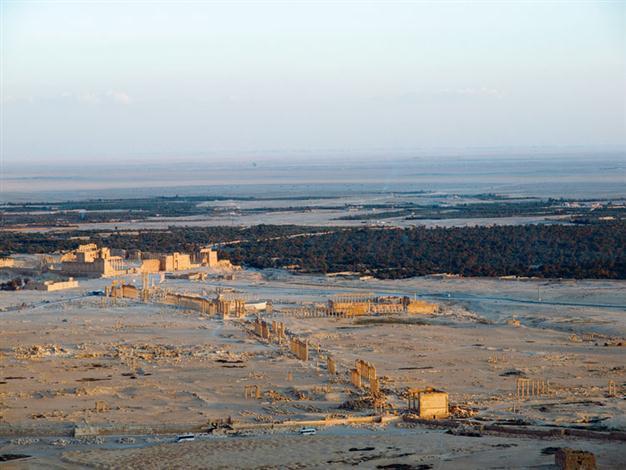Touring the ancient desert city
Wilco Van Herpen

Palmyra is becoming more popular among adventure travelers and even some archeologists. Nowadays only the pillars and remains of the temple and all the other buildings are standing there. Hürriyet Daily News photo by Wilco Van Herpen
Entering the Temple of Baal-Shamin in Palmyra, Syria is amazing. You find an inner yard surrounded by walls. Although most of the buildings and pillars have collapsed, you still can see the grandeur of the past. The first thing you see is of course the temple. It rises up in front of you. A row of seven big pillars beside the remnants of the main building lead you to what once was the entrance of the temple. Those pillars have been facing rain and sandstorms but still stand firm in the desert place.Leading to the temple is a narrow tunnel. Part of its roof has collapsed, but a part is still as it used to be, with a ceiling. This tunnel was used to lead the animals that were going to be sacrificed at the temple. Near the tunnel is a narrow ditch. It passes under the buildings and ends in the temple. This ditch was an old sewer system that was used to drain the blood from the animals that were sacrificed to the gods in the temple. Every time I visit places of the ancient world I am so surprised by the way those people used to design houses, temples and cities. They thought of everything: the sewer system, the entrance roads, heating (or cooling down) buildings and more. They found practical solutions for problems that nowadays would require a team of specialists to solve.
The temple itself is breathtaking. You enter the temple and see the place where an altar once stood. Nine steps lead to this altar, and the altar is decorated with all kinds of symbolic figures. I asked a local about the name Palmyra and he told me in the old times the whole area was a palm tree forest.
Unfortunately all those trees have been cut so now all that remains is the ancient city. It was, according to legend, King Solomon who built this beautiful old city. Tadmor, the ancient name of Palmyra, is even mentioned in the Hebrew Bible.
You need at least two or three days at this gorgeous place in the desert if you really want to see everything in Palmyra. Early in the morning at around 8 or 9 a.m., you should start with a visit to the temple or old city. At around 11 a.m. when it is too warm to walk around, you can go back to your hotel, have a nice lunch in town and enjoy a siesta. After 3 p.m. you can return to the ancient city and continue the tour.
It was time for me to cross the street and go to the old city. There is a 1,100 meter long pillar road with a slight bend in it. This curve is unique in the ancient world; there is no other place where you can find such a road. At the entrance a Syrian man is waiting with his camels. A camel calf is lying in the sand; it is probably too hot to stand on its legs. Small groups of tourists are wandering around in the ruins. It is impressive to see such a long road with scattered remains of buildings, bathhouses and shops.
At the end of the road you can find the castle, but it is kind of difficult to find it since nothing more remains than just a lot of stones scattered around the place. I wonder how it was for the two merchants who “discovered” the place after a long time of being nothing more than a forgotten ghost town. The merchants had stayed in Aleppo and overheard some rumors of an ancient city two days’ travel away. They organized a guide, camels and some servants and took off. After their discovery, Palmyra became more popular among adventure travelers and even some archeologists. Seeing all those beautiful places, I often wonder how it originally was. It must have been such a busy place with all the people living in Tadmor, trading or visiting the temple to offer an animal to the gods and pray for rain or another child. Nowadays only the pillars and remains of the temple and all the other buildings are standing there, sandblasted by the desert winds.
















